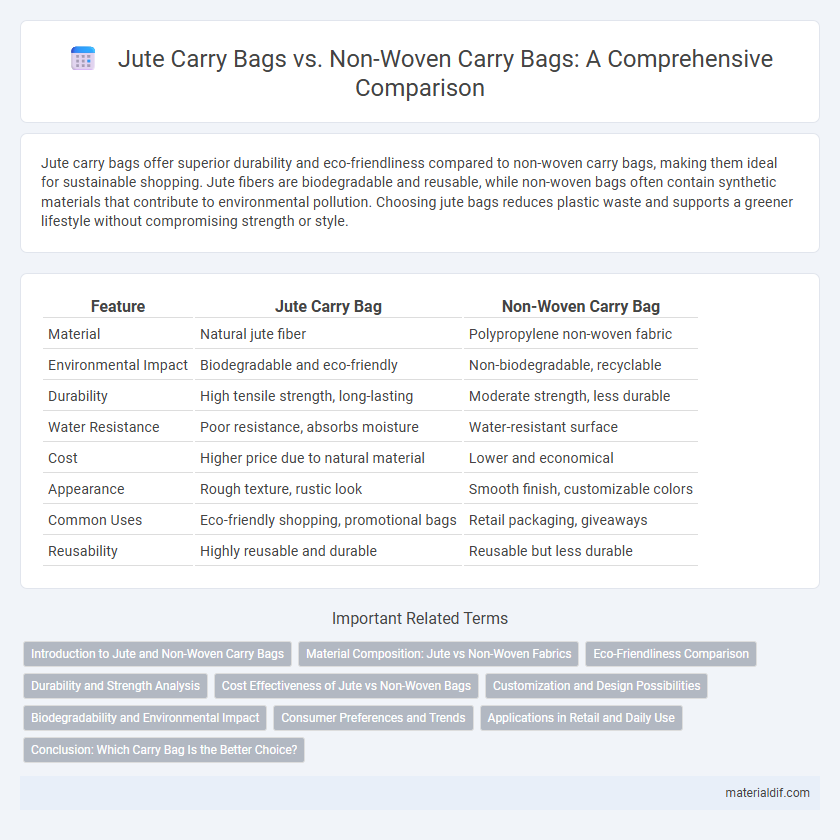Jute carry bags offer superior durability and eco-friendliness compared to non-woven carry bags, making them ideal for sustainable shopping. Jute fibers are biodegradable and reusable, while non-woven bags often contain synthetic materials that contribute to environmental pollution. Choosing jute bags reduces plastic waste and supports a greener lifestyle without compromising strength or style.
Table of Comparison
| Feature | Jute Carry Bag | Non-Woven Carry Bag |
|---|---|---|
| Material | Natural jute fiber | Polypropylene non-woven fabric |
| Environmental Impact | Biodegradable and eco-friendly | Non-biodegradable, recyclable |
| Durability | High tensile strength, long-lasting | Moderate strength, less durable |
| Water Resistance | Poor resistance, absorbs moisture | Water-resistant surface |
| Cost | Higher price due to natural material | Lower and economical |
| Appearance | Rough texture, rustic look | Smooth finish, customizable colors |
| Common Uses | Eco-friendly shopping, promotional bags | Retail packaging, giveaways |
| Reusability | Highly reusable and durable | Reusable but less durable |
Introduction to Jute and Non-Woven Carry Bags
Jute carry bags are crafted from natural, biodegradable fibers derived from the jute plant, known for their eco-friendly, durable, and breathable properties. Non-woven carry bags, made from synthetic polypropylene fibers bonded together without weaving, offer lightweight, water-resistant, and cost-effective alternatives. Both materials serve as sustainable options compared to single-use plastic bags, with jute emphasizing environmental sustainability and non-woven focusing on practicality and affordability.
Material Composition: Jute vs Non-Woven Fabrics
Jute carry bags are made from natural fibers derived from the jute plant, offering strong, biodegradable, and environmentally friendly properties, while non-woven carry bags are composed of synthetic fibers like polypropylene, which provide durability and water resistance but lack biodegradability. The cellulose content in jute fibers enhances its breathability and tensile strength, making jute bags sustainable and ideal for eco-conscious consumers. In contrast, non-woven fabrics involve a bonding process that creates a lightweight, cost-effective material but contributes to plastic waste and limited recyclability.
Eco-Friendliness Comparison
Jute carry bags offer superior eco-friendliness compared to non-woven carry bags due to their biodegradability and renewable natural fiber composition, significantly reducing plastic pollution. Unlike non-woven bags made from polypropylene, a petroleum-based product, jute bags decompose naturally within a few months without releasing harmful microplastics. Moreover, jute cultivation supports carbon sequestration and requires less energy and chemical input, reinforcing its sustainable advantage over synthetic alternatives.
Durability and Strength Analysis
Jute carry bags exhibit superior durability and strength compared to non-woven carry bags due to their natural fiber composition, providing enhanced tear resistance and load-bearing capacity. The coarse, fibrous texture of jute enables it to endure repeated use and heavy weights without significant wear, making it ideal for eco-friendly, long-term applications. Non-woven carry bags, typically made from polypropylene, have lower tensile strength and are more prone to tearing under stress, reducing their lifespan in comparison to jute alternatives.
Cost Effectiveness of Jute vs Non-Woven Bags
Jute carry bags offer superior cost effectiveness due to their durability and reusability, reducing the frequency of replacement compared to non-woven bags. While non-woven bags have a lower upfront cost, their shorter lifespan and limited strength lead to higher long-term expenses. Investing in jute bags supports sustainable, economical choices by lowering overall carrying and disposal costs.
Customization and Design Possibilities
Jute carry bags offer extensive customization options such as natural textures, eco-friendly dyes, and intricate printing techniques that enhance brand aesthetics while promoting sustainability. Non-woven carry bags provide vibrant color choices and cost-effective printing methods, though they lack the tactile appeal and biodegradability of jute. Design possibilities in jute bags emphasize durability and a premium feel, making them ideal for high-end branding, whereas non-woven bags cater to budget-friendly, mass-produced promotional uses.
Biodegradability and Environmental Impact
Jute carry bags are highly biodegradable, breaking down naturally within a few months and enriching soil without leaving harmful residues, making them an eco-friendly choice. Non-woven carry bags, typically made from polypropylene, have a slower degradation rate and contribute to microplastic pollution, posing long-term environmental risks. Choosing jute bags significantly reduces landfill waste and carbon footprint, supporting sustainable practices and preserving ecosystems.
Consumer Preferences and Trends
Jute carry bags are favored by environmentally conscious consumers due to their biodegradability and natural fiber composition, aligning with the growing demand for sustainable products. Non-woven carry bags appeal to budget-conscious shoppers because of their affordability and lightweight nature, despite limited recyclability. Market trends indicate a rising preference for jute bags among eco-aware demographics, while non-woven bags maintain popularity in mass retail settings.
Applications in Retail and Daily Use
Jute carry bags offer superior durability and eco-friendliness, making them ideal for retail stores aiming to provide sustainable packaging and enhance brand image. Non-woven carry bags are lightweight and cost-effective, widely used in daily shopping and promotional events due to their water-resistant properties. Both types support retail applications, but jute bags appeal more to environmentally conscious consumers seeking reusable options.
Conclusion: Which Carry Bag Is the Better Choice?
Jute carry bags offer superior environmental benefits with their biodegradability and natural fiber composition, making them an eco-friendly alternative to non-woven carry bags, which are primarily made from synthetic polypropylene and have limited recyclability. Durability and reusability lean in favor of jute bags, as their robust texture enables longer use, while non-woven bags may degrade faster under heavy loads. Considering sustainability, durability, and overall ecological impact, jute carry bags emerge as the better choice for environmentally conscious consumers seeking reusable shopping solutions.
Jute Carry Bag vs Non-Woven Carry Bag Infographic

 materialdif.com
materialdif.com